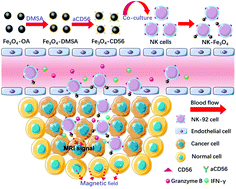Surface specifically modified NK-92 cells with CD56 antibody conjugated superparamagnetic Fe3O4 nanoparticles for magnetic targeting immunotherapy of solid tumors†
Abstract
Although there has been significant progress in the development of tumor immunotherapies, many challenges still exist for the treatment of solid tumors. Natural killer (NK) cells possess broad-spectrum cytotoxicity against tumors, but their limited migration and infiltration abilities restrict their application in solid tumor therapies. Here, we combined a facile and efficient magnetic-targeting strategy with NK cell-based therapy to develop a novel immunotherapy approach for treating solid tumors. Anti-CD56 antibodies were conjugated with Fe3O4 nanoparticles, which could specifically bind with NK-92 cells endowing them with a magnetic field driven targeting ability. These NK–Fe3O4 biohybrid nanoparticles were able to facilitate directional migration to the tumor site in vivo under external magnetic field guidance and efficiently inhibit tumor growth. These functionalized NK cells represent a novel approach for solid tumor therapy and may provide a promising modality for cancer interventions in the future.



 Please wait while we load your content...
Please wait while we load your content...